Imagination Announces B-Series GPU IP: Scaling up with Multi-GPU
by Andrei Frumusanu on October 13, 2020 4:00 AM EST- Posted in
- GPUs
- Imagination Technologies
- SoCs
- IP
Performance, Efficiency, and a Raytracing Teaser
Overall, today’s announcement of the B-Series has been actually quite exciting. Although the actual GPU microarchitecture has seen only somewhat minor advancements compared to last year’s A-Series, Imagination’s take on multi-GPU is quite innovative and unlike what we’ve seen in past multi-GPU attempts.
The new “pull” decentralised GPU design is certainly something that offers tremendous flexibility. It won’t be something that has absolutely perfect scaling, as there might be some edge-cases where things might get bottlenecked, however Imagination expects extremely good scaling on average.
The B-Series’ roadmapped +30% performance improvement is said to have been achieved through both microarchitectural and physical design improvements (around 15%), with the rest being achieved through the PPA advantage of choosing a multi-core GPU configuration.
Probably what’s more important than the GPU IP itself, is that Imagination says they have actually licensed out and delivered the IP customers already – which is a contrast to past generation Imagination GPU IP announcements where things were publicised ahead of not only the IP being delivered, but ahead of it even being completed.
We still haven not seen or heard of any A-Series design wins, so we do hope there will be more news on that in regards to the B-Series.
Industry sources say that the major demand-driver for Imagination GPU IP right now is the high-performance GPU market in China, where there’s apparently a major hunger and need for domestic designs that are disconnected from US suppliers such as AMD and Nvidia.
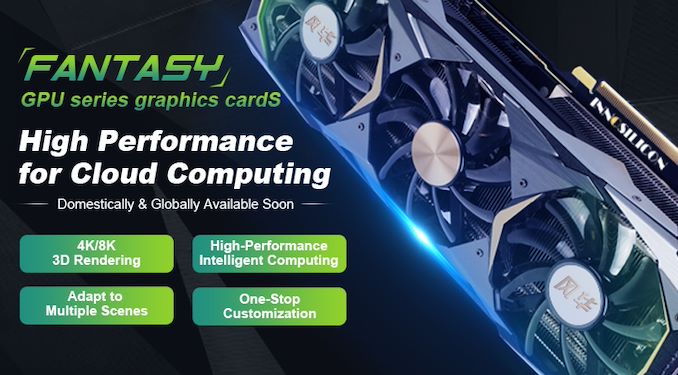
Innosilicon Fantasy GPU Series
One such design win is Innosilicon’s recently announced “Fantasy” graphics cards series. Innosilicon to date was known as an ASIC IP design house for various miscellaneous IP blocks, such as providing Nivdia’s GDDR6’s memory controllers.
Roger Mao, Vice President of Engineering, Innosilicon, says;
“Imagination’s BXT multi-core GPU IP delivers the level of performance and power efficiency we had been looking for. Innosilicon has a solid track record in delivering first class high-speed and high-bandwidth computing solutions in advanced FinFET process nodes. Building on this success and strong customer demand, we are announcing our upcoming product which is a standalone high-performance 4K/8K PCI-E Gen4 GPU card, set to hit the market very soon, that will power 5G cloud gaming and data centre applications. With a solid foundation in GDDR6 high-speed memory, cache coherent chiplet innovation and high-performance multimedia processor optimisation, a move into a standalone PCI-E form-factor GPU is natural for us. Thanks to BXT’s multi-core scalable architecture, we are able to build a customised solution to meet the high-end data centre demand with fantastic cloud and computing performance.”
If this pivot towards higher-performance computing works out for Imagination remains to be seen. It certainly seems that at least having a tangible design win such as the above would certainly be a big improvement given that we’ve never seen publicly acknowledged 8XT, 9XT, 9XTP or even A-Series silicon.
Level 4 Raytracing for C-Series
Lastly, Imagination is also teasing their future C-Series architecture, confirming that it’ll be a full raytracing capable design. Although Imagination has had Raytracing IP and capable GPUs for the better part of the decade, it took Nvidia’s RTX series as well as AMD’s inclusion of Raytracing in the new generation consoles as well as RDNA2 series to seriously kick-start the RT ecosystem into gear. Imagination is taking full advantage of this revival as it dusted off its RT IP that previously had been shelved a few years ago.
Beyond confirming that the new C-Series will have ray tracing capabilities, Imagination further confirms that this will be an implementation using the company’s fullest of capabilities, including BVH processing and Coherency Sorting in hardware, a capability the company denotes as a “Level 4” ray tracing implementation, which would be more advanced than what current generation Nvidia and AMD GPUs are able to achieve at a “Level 3”.
Imagination explains that they’ve had these capabilities for a long time, and when discussing with customers as to what kind of capabilities they would like to see in future IP, they had chosen to go for the full-blown implementation as this was the better future-proof design choice.
Overall, it seems like Imagination is on a path where it tries to diversify itself to markets other than the typical low-power GPU use-cases. The next few years will definitely be interesting for the company, and particularly the new distributed multi-GPU approach will be something to pay attention to.


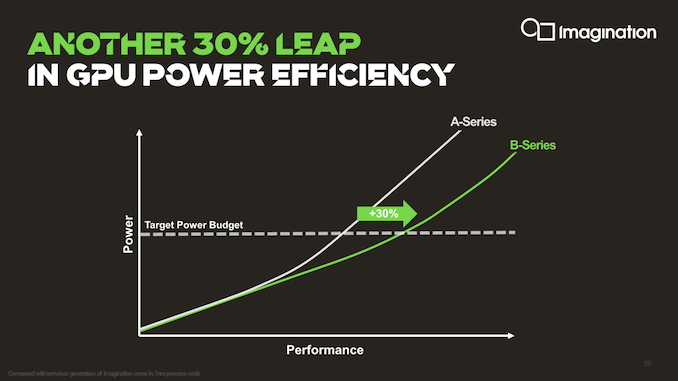
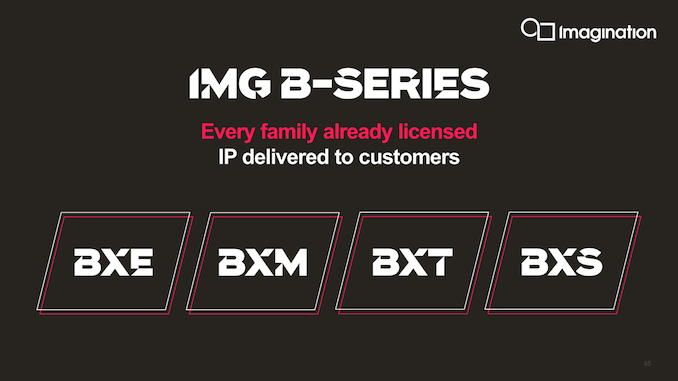
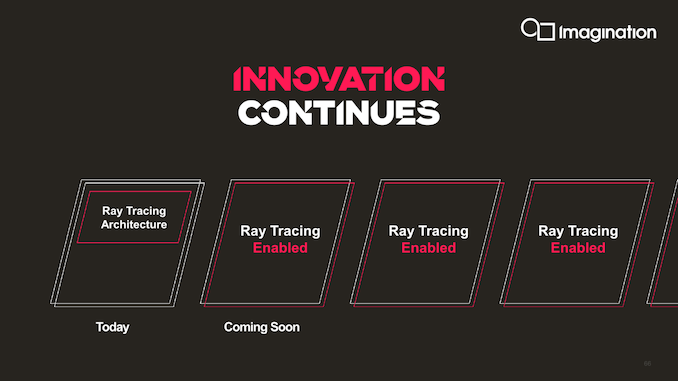
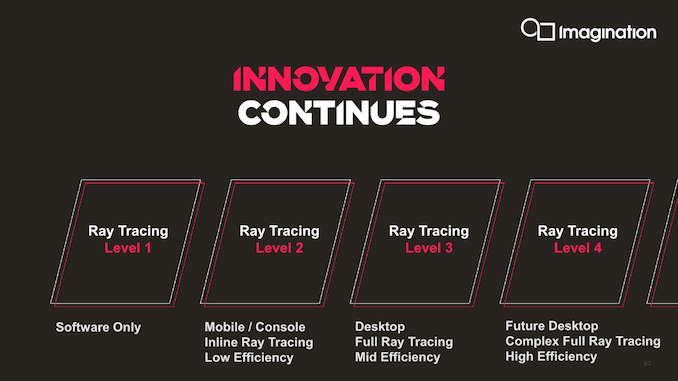








74 Comments
View All Comments
Obi-Wan_ - Tuesday, October 13, 2020 - link
Is this something that could transition to the desktop consumer space at some point? Either the Imagination IP or just the pull/push change.yeeeeman - Tuesday, October 13, 2020 - link
I am also wondering about this.To me it seems a bit strange why they don't take this step given that their revenues from mobile are getting slimmer and slimmer.
Arsenica - Tuesday, October 13, 2020 - link
Imagination Technologies may be British but it's owned via shell-companies by the Chinese government. Finding viable revenue streams no longer matters to them.This product may eventually transition to China-only PCs, but in the meantime (as it's implied in Innosilicon PR) it's targeted for Chinese data centers.
Threska - Wednesday, October 14, 2020 - link
Getting the Apple contract is indeed a big deal.https://technode.com/2020/04/15/imagination-techno...
Otritus - Tuesday, October 13, 2020 - link
I would imagine the consideration is money and competition. Imagination has no mindshare in the consumer market, and lacks many gaming-centric features (and good drivers) that would essentially eliminate adoption. The MGPU seems like it will be the future of gpu computing, but right now putting multiple slabs of silicon together and efficiently connecting them is expensive and power hungry which is undesirable.myownfriend - Tuesday, October 13, 2020 - link
What gaming centric features are they missing and how do you know they have shitty drivers?Otritus - Wednesday, October 14, 2020 - link
To my knowledge, their gpus do not currently support APIs such as DX12, lack a freesync/gsync competitor, reduced input latency, game streaming, etc. In terms of drivers they have no public drivers for windows or linux, meaning their drivers are unoptimized for desktop usage.myownfriend - Wednesday, October 14, 2020 - link
You're conflating a few things. Adaptive sync or Freesync is a feature of the display controller not the GPU. As has been stated, Apple has used Imagination's GPU IP for years and that includes the iPad Pro which supports dynamic refresh rates.Game streaming is a way that software uses a GPUs hardware decoder. All it would require is something like Moonlight supporting it.
I don't know what reduced input latency is supposed to refer to here since that has to do with a bunch of things that aren't the GPU.
I can't say for certain if they support DirectX 12 but they have supported OpenGL, Vulkan, and DirectX 11 for a long time. Considering many DirectX 11 GPU were able to support DX12 via a driver update, that's very likely something that they could do the same. If they can't then they would still be an option for Linux users.
Lastly, Imagination makes GPU IP meaning they don't manufacture actual chips. They license out designs so you're not gonna go to Imagination's website and see download list for their drivers. You can, however, look at Imagination's YouTube channel and see their cards running on Linux and Windows desktops so those drivers exist.
Kangal - Friday, October 16, 2020 - link
He's "Technically wrong" but from the consumer's viewpoint he's entirely right. There's a lot of work ImaginationTechnologies have to do to get their PowerVR GPUs to the desktop space then catch-up and compete against the likes of Nvidia's Ampere GPUs (industry standard).Normally, I would say that's easy. PowerVR has actually been an innovator and sometimes a leader in the GPU field, albeit from the shadows. But now? I doubt it.
Rant:
Firstly with 2020 being what it is. More importantly, the company is shifting massively with their CEO ousted, board members changing, and their Senior Engineers leaving after the aggressive Chinese buyout. The British seem to be angry about the whole thing, but it was so predictable, they're too naive. I'm not sure if what's left of PowerVR will have the leadership and talent anymore to get the job done. Perhaps these A-Series and B-Series are the end of their hard work, and in a few years time they will hit the wall (kinda like Intel did after SkyLake). Their short-handed won't affect Apple much, since they actually have their own GPU designers and don't rely on PowerVR much anymore. So I can see these valuable staff being poached by Apple-SoC, ARM-Mali or even Qualcomm-Adreno teams. Hopefully they don't add to the monopoly with Nvidia/AMD teams.
myownfriend - Friday, October 16, 2020 - link
I can agree with all that. It would be very difficult for them to break into a field that's been team red and team green for some people's entire lives. If they do fall apart, I'd say Nvidia would be the worst case scenario as their recent purchase of ARM is allowing them to wield a gross amount of power.